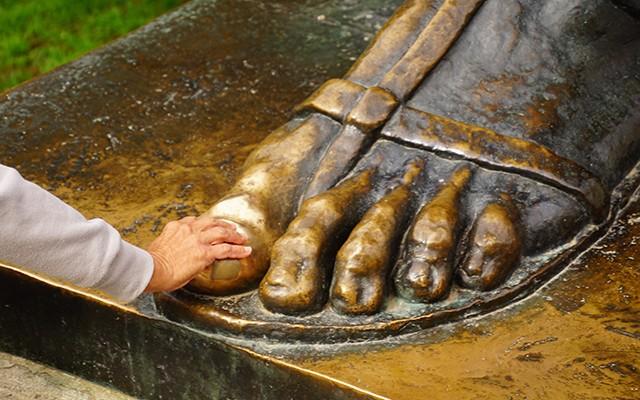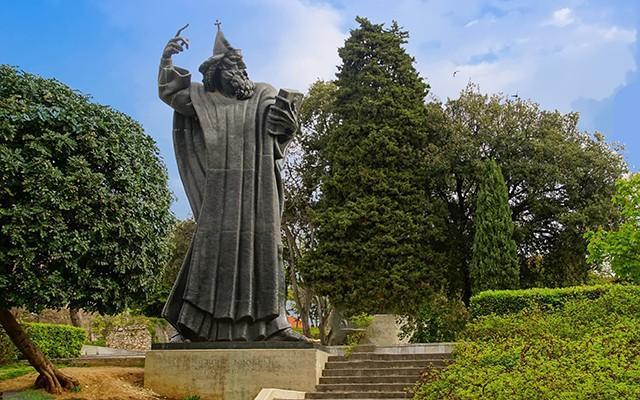Grgur Ninski
Gregory of Nin (Grgur Ninski): A Pillar of Croatian Identity and Language
History and Significance
One of Split's most iconic landmarks is the statue of Gregory of Nin, prominently located at the northern entrance of Diocletian's Palace near the Golden Gate. This imposing sculpture, crafted by the renowned Croatian artist Ivan Meštrović, soars over six meters in height.
Croatian culture reveres Gregory of Nin, a bishop in the 10th century, for his critical contributions to the development of the old Slavic language and the Glagolitic alphabet. It is believed that touching the toe of his statue and making a wish will compel him to fulfil it, a testament to his enduring legacy among Croatians.
Gregory's Era
His efforts were pivotal in preserving the Croatian language and culture, despite the challenges. However, Gregory's endeavours faced significant opposition from the Pope and Dalmatian bishops. King Tomislav and the clergy ultimately marginalised Gregory due to this resistance. The Archbishop of Split seized control over the church, leaving Gregory of Nin without influence or power, yet his legacy of championing the Croatian language and culture remains undisputed.
Grgur Ninski As A Tourist Attraction
A widely held belief associated with the statue suggests that touching the statue's right toe brings good fortune, rendering the toe polished from countless touches.
Artistic Features of the Statue
Ivan Meštrović, the statue's creator, is among the most notable Croatian and global sculptors of the 20th century. His works adorn numerous public spaces in Croatia and worldwide. The statue of Grgur Ninski in Split conveys emotional power and spiritual devotion, traits common in Meštrović's works. Grgur Ninski, towering over four metres tall, commands his surroundings.
City Tours featuring the Statue of Grgur Ninski
The presence of Grgur Ninski in Split signifies more than just a monument to a great historical figure; it's an artwork reflecting the deep cultural and historical layers of the Croatian people. It serves as a testament to the rich history and culture that the cities of Split and Croatia offer.
City Tours featuring the Statue of Grgur Ninski
A Walking Tour of Diocletian's Palace and the Old Town
Cultural-Historical Tour of Split
Tours Focused on Croatian Greats: Several agencies offer tours centred on significant historical figures in Croatia, with Grgur Ninski being a focal point due to his importance for the Croatian language and culture.
The Significance Of Grgur Ninski To The Residents Of Split Is Noteworthy
Grgur Ninski stands as a pivotal figure in the preservation of the Croatian language and identity, especially during a time when Latin was the liturgical norm. People view his determination to conduct mass in the vernacular and his advocacy for the right to use the Glagolitic script as fundamental achievements in shaping Croatian national identity. The people of Split, like many Croatians, view Grgur Ninski as a symbol of resistance and national pride.
Frequently Asked Questions and Answers
Who was Grgur Ninski?
- Grgur Ninski was a bishop in the 10th century who advocated the use of the Old Church Slavonic language and Glagolitic alphabet in religious ceremonies, playing a key role in preserving the Croatian language and culture.
Why is the statue of Grgur Ninski popular among tourists?
- The statue is popular for its historical and cultural significance and the belief that touching its toe brings luck.
When was the statue of Grgur Ninski erected?
- The statue was erected in 1929, a masterpiece by the renowned Croatian sculptor Ivan Meštrović.
What does the statue of Grgur Ninski symbolise?
- It symbolises the fight for national identity and the right to use one's own language and script in religious ceremonies.
How did Grgur Ninski influence Croatian history?
- Grgur Ninski played a crucial role in preserving the Croatian language and identity during periods dominated by foreign influences, becoming a symbol of resistance and national pride.




Comments